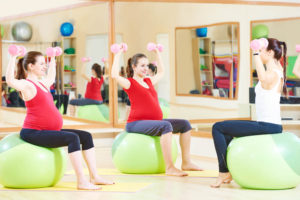So your back hurts, you’ve got swelling ankles and you have trouble sleeping right? (and yes, I don’t want to talk about constipation and bloating).
So we can gladly confirm you’re pregnant and that’s sweet, -congratulations. So now all you care about is something you could possibly do to reduce the pain and ache associated with pregnancy. It turns out that there is something you can do:
Exercise –simple. Engaging yourself in one or more forms of exercises during pregnancy has many benefits: it improves your mood, reduces lots of symptoms of pregnancy, such as constipation, morning sickness, and fatigue, and also quickens postpartum recovery.
Now that you are expectant, it is not the time to put your legs up to take some rest for another nine months, right?
Not at all, you need regular exercise. According to experts, you need regular exercise while pregnant and so as to improve your general health, especially your heart, it also gives you energy and boosts your self-image.
It does not matter if until now you have been a sofa slacker or an iron woman, there is a lot to benefit from being active during pregnancy (1).
It is also absolutely safe, provided there is no contrary advice by your doctor, (if possible, it is also important to get a recommendation from your doctor before starting a new exercise routine or before you start to engage yourself in a new physical activity during your pregnancy that you have not been engaging in before).
How much exercise do you need during pregnancy?
The American College of Obstetricians and Gynecologists (ACOG) have suggested that pregnant women get a minimum of 21 minutes of moderate physical activity a day(2), for most (and possibly every day) of the week.
You may begin to wonder what counts toward these 30 minutes.
Well, the answer is straight forward; as for your heart and general health, three 10-minute walks throughout the day does just the same benefit as you’d enjoy from a 30-minutes workout on the treadmill or cycling in the gym.
To this end, even a motionless workout or a non-exercise activity, of around 15 minutes of vacuuming and some 15-minutes of small yard work will count toward your daily workout goal.
7 safe workouts during pregnancy
Walking
Who doesn’t walk?
Well, this is the most common exercise for pregnant women. Like we all know, walking is one of the safest things we do, it is safe for everyone, and this also includes the pregnant woman who is just starting to get involved in exercising.
Walking doesn’t pose serious risks, the risk of falling is low, and the exertion level is easy to control. A brisk walk may have a low impact on the joint and muscles, but still leads to a full body workout and it goes a long way in improving your cardiovascular fitness too.
Water sports
Most water sports like water aerobics, swimming, and water walking are all fun and safe sports for pregnant women.
As for swimming, almost all body muscles are worked without the fear of overheating. Water aerobics is ideal for your cardiovascular fitness. Such water sports are all safe because there is no risk of loss of balance and your body weight is supported by the water, so there is a low risk of muscle tension.
All water activities are effective for women with back pain or those experiencing leg swelling during pregnancy, studies have shown that it alleviates these symptoms.
Stationary cycling
Cycling is a wonderful cardiovascular exercise which helps improve your leg muscle strength. Stationary cycling is particularly good for pregnant women because of the growth of the stomach, especially as balance will be affected or difficult during the third trimester.
Pilates
Pilates helps improve your core strength balance, reducing your risk of falling. It also helps relieve the lower back pain which is associated with weight gain as a result of your pregnancy.
Someone who is just trying out Pilates for the first time should start from a few weekly sessions, each should last for 5 to 10 minutes. Such a person can try to improve their workout time to 30 to 60 minutes for one or two times per week.
Pregnant women who are used to Pilates should continue their usual routine in the first trimester, but should avoid the following situations:
Twisting their abdomen or stomach.
Laying on their back.
Avoid raising your legs above your head and your heart.
Avoid staying still for an extended period.
There are many gyms and studios where prenatal Pilate classes are offered, you can also get similar classes online.
Weight training
 Light to moderate weight lifting during pregnancy have been found to be very good. There are no known adverse effects in pregnant patients who engage in weight lifting during pregnancy, especially those who have been engaging in weightlifting before their pregnancy.
Light to moderate weight lifting during pregnancy have been found to be very good. There are no known adverse effects in pregnant patients who engage in weight lifting during pregnancy, especially those who have been engaging in weightlifting before their pregnancy.
However, it is not advisable for those who were not used to weightlifting before conceiving.
Studies done on weightlifting during pregnancy have shown that it is beneficial to engage in weightlifting during pregnancy. It provides an improvement in both flexibility and strength.
The activity will help your body adapt to the various physiological change which occurs in the body of a pregnant woman. With body strengthening which is gotten from weightlifting and training, women may find that they are able to tolerate their heavier body weight including their altered center of gravity.
Yoga
Yoga helps strengthen the core abdominal muscles, relieves back pain and also helps you to relax. Research has also shown that it may help make labor more comfortable and shorter.
To begin, you may try a prenatal class, these are gentler and they should focus on relaxation, which serves as good preparation in anticipation for labor. You should endeavor to avoid “hot yoga” and not lie on your back after your first trimester. Should you feel something is not right, contact your fitness coach or expert.
Running
When done moderately, running can be safe for women who were frequent runners before becoming pregnant. Women who were not used to running or have never run before pregnancy should not get involved. Depending on the person, there is no need for a reduced intensity or frequency in the running regime.
Preparation for labor: Squatting and Pelvic Tilts
The American Pregnancy Association have recommended special exercises during pregnancy, which is to prepare your body for both labor and childbirth.
Squatting
Squatting helps you during labor to open the pelvis. Therefore it’s a good idea to squat or practice it during pregnancy.
Stand with your feet on a flat floor, with your shoulders width apart and a straight back.
Slowly lower yourself keeping your feet flat on the floor and your knees shouldn’t be ahead of your feet.
Slowly push yourself up after holding out for about 10 to 30 seconds.
Pelvic Tilts
Pelvic tilts can strengthen your abdominal muscles and also help reduce your back pain.
Go down on your hands and knees.
Tilt your hips forward while pulling your belly in and arching the back
Hold it out for some seconds.
Release it and let your back drop.
Repeat for about 10 times.
When to Stop Your Workout
There are signs and symptoms which could mean you have put too much strain or stress on your body, once you detect any of these, you have to stop and immediately call your doctor.
- Fluid dropping or vaginal bleeding.
- Difficulty, laborious or discomfort in breathing.
- Palpitations in the heart or chest pain.
- Vomiting, headache or nausea.
- Dizziness or fainting
- Overheating, a sudden change in temperature and clammy hands
- Swelling, pain in your calves or ankles.
- Pain in the abdomen.
- Decreased movement of the fetus.
- Blurred vision.
Reasons you need to exercise during pregnancy
- Exercises help to increase the heart rate and also improves blood circulation.
- Improves body flexibility and strength.
- It supports and controls weight gain in a healthy manner.
- Prepares your muscles for labor and delivery.
- Reduces your labor process.
- Increases your chances of having a natural birth.
- Reduces the need for taking pain relief.
- Accelerate the postpartum recovery process.
- Reduces your risk of hypertension and gestational diabetes.
- Reduce the risk of preterm or premature delivery.
- It can also give a child a healthier start.
Studies have shown that exercises in pregnant women help reduces fetal heart rate. Newborns are also given a healthier beginning by promoting their birth weight, reduction in their fat mass, better stress tolerance, and advancement in the maturation of their neurological behavior.
Tips for safe workout sessions
- Here are some safety workout tips that can keep you safe as you work out. Remember to always ensure the following:
- Start with 5 minutes of warming up and 5 minutes of stretching (3).
- Then begin each session with about 5-10 minutes of slower exercise, ending with gentle stretches.
- Wear clothes that are comfortable and are loose fitting, don’t forget, a nice bra is important.
- Choose shoes that are supportive and are designed specifically for your chosen exercise, this is to avoid injury.
- To avoid injury, always exercise on flat and level surfaces.
- Frequently eat small meals all through the day and do not engage in any exercise at least an hour after eating.
- Water is good, drink lots of it, before, during and after your exercise session, it helps to maintain your level of hydration.
- During pregnancy, your body requires lots of oxygen.
- Risk of injury is increased by the relaxing hormone which is produced during pregnancy, causing a stretch in the ligaments supporting the joints.
P.S. If you find this post useful and interesting, please do not hesitate to share it.
If you have something to add- Leave comment below!

Leave a Reply